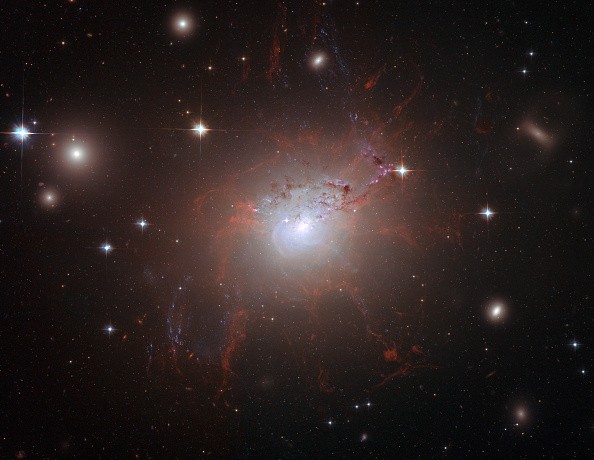ALMA Lensing Cluster Survey team used a natural cosmic telescope to find a rotating baby galaxy. The involved scientists claimed that modern space telescope models couldn't do this.

This handout image of the giant, active galaxy NGC 1275, obtained August 21, 2008 was taken using the NASA/ESA Hubble Space Telescope?s Advanced Camera for Surveys in July and August 2006. It provides amazing detail and resolution of fragile filamentary structures, which show up as a reddish lacy structure surrounding the central bright galaxy. These filaments are cool despite being surrounded by gas that is around 55 million
Astronomers used ALMA (Atacama Large Millimeter/submillimeter Array) to identify the faint rotating baby galaxy, which is only 1/100th the size of the giant Milky Way Galaxy.
They added that ALMA was assisted by a gravitational lens effect. Thanks to this innovation, the scientists were able to explore a small and dark "normal galaxy."
ALMA Lensing Cluster Survey's experts also claimed that this galaxy is the first representative of the main population of the oldest galaxies. They added the current space discovery could help various astronomers and space scientists to understand galaxy evolution's initial stage.
Why modern space telescopes couldn't find it
According to Phys Org's latest report, modern-day space telescope models don't have the capability to capture dark and small galaxies.

This image, released by NASA on December 19, 2002, shows the young, forming galaxy POX 186 and is a composite of three images taken by the Hubble Space Telescope in March and June, 2000. The 900 light-year wide galaxy is very small in galactic terms and is made up of only 10 million young stars. POX 189 lies in the constellation Virgo and is 68 million light years from earth.
"Many of the galaxies that existed in the early universe were so small that their brightness is well below the limit of the current largest telescopes on Earth and in Space, making it difficult to study their properties and internal structure," said Nicolas Laporte, a space expert at the University of Cambridge.
He added that only the natural cosmic telescope was the only one that could capture the galaxy's emitted light called RXCJ0600-z6. Laporte also explained that the light was highly magnified by the gravitational lensing.
How the natural cosmic telescope captured it
SciTech Daily explained that the natural cosmic lens used in the new space study relies on the process called gravitational lensing. This method is a natural phenomenon in which the heavenly body's emitted light is bent by the gravity of a massive body, such as galaxies.
Experts said that gravitational lensing happens when the galaxy's gravity acts like a massive telescope or lens. Astronomers even previously proposed using the Sun to peer closer into exoplanets.
If you want to know more info, all you need to do is click here. For more news updates about other space discoveries, always keep your tabs open here at TechTimes.
Related Article: NASA Ingenuity Helicopter Successfully Completes Second Flight, Aims to Fly Faster
This article is owned by TechTimes
Written by: Griffin Davis








